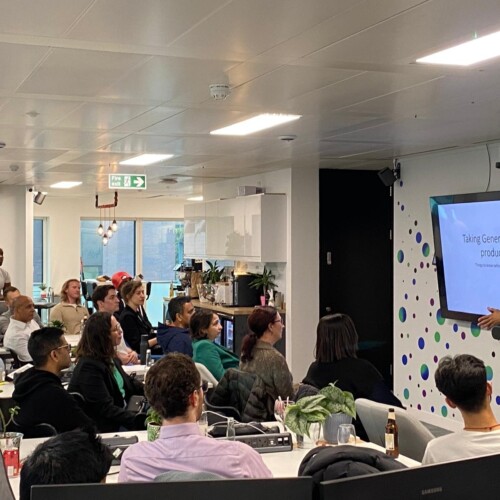Cloud & Platforms
A transparent, repeatable model from forensic analysis, to the development of a prescriptive approach to delivery with a clear focus on capability building and handover.
Stary your journey today
Cloud technologies such as those provided by AWS and Microsoft Azure have brought many solutions for legacy issues suffered by almost all organisations at some time or another. One of these is the slow delivery of software and code into production, often due to insufficient collaboration between the developers and the operations team. Agile project management methodologies can mean developers can produce fixes and feature updates faster – if these are held up in delivery due to lack of available infrastructure, it unnecessarily lengthens the software development lifecycle, and leads to frustration from the development team and the business.
To solve this, a culture of DevOps can be fostered in the organisation, to synergise the development and operation teams through automation. For companies with no experience in this, DevOps Consultancy can provide the necessary advice and training to enable the transformation of those teams into a more productive unit.
There are an ever-increasing number of SaaS solutions whose providers offer utility, or “pay-as-you-go”, pricing models. Many companies are switching to these as they bring predictable expenditures on a monthly or annual subscription. For the suppliers of these applications and web-based services, this can mean customers can migrate away relatively easily compared to the traditional upfront licence and support model. For these providers, adopting a DevOps culture is necessary to remain competitive, as well as produce fixes, updates and new features fast enough to retain customers.
DevOps is the concept of combining or at least synergising agile development and traditional operational roles and teams. It does this through a collection of tools and practices such as infrastructure as code (IaC), automation, microservices architecture, continuous integration and continuous delivery (CI/CD) pipelines and observability, objectives and key results (OKRs). These topics are discussed in some of our other blogs, like Cloud Native Development, Cloud Automation Services and Serverless Computing Services.
Find out more on how we can help you build your product, platform, or service
Infrastructure as Code(IaC) is the automation of manual operations for infrastructure management and provisioning. IaC makes it simpler to change and distribute configurations by generating configuration files that contain your infrastructure specifications.
IaC is a key DevOps practice along with being a part of continuous delivery. With IaC, DevOps teams can collaborate using a standardised set of processes and tools to deliver apps and the infrastructure that supports them quickly and reliably.
Automation – Automate the process of deployment. The degree to which deployments are totally automated and don’t need manual intervention is known as deployment automation.
Automate test execution. Software tests are continuously run automatically (rather than manually) throughout the development process in a practise known as test automation. Effective test suites are dependable in that they only pass release-ready code and identify actual faults. Remember that the construction and upkeep of automated test suites should fall mostly to developers.
Microservices Architecture – The term “microservices architecture” refers to an architectural design approach for creating applications. With microservices, a huge programme can be divided into smaller, independent components, each with an own set of responsibilities.
Continuous Integration – Many software development teams are accustomed to spending days or even weeks developing new features on branches. All of these branches must be integrated, which will take a lot of time and effort. High-performing teams maintain branches that are short-lived (less than one day’s work) and often integrate them into trunk/master in accordance with our approach of working in small batches and building quality in. A build procedure that involves running unit tests is triggered by each change. The process is promptly fixed by the developers if any step fails.
Continuous Delivery is a development method where software is maintained in a deployable form throughout its lifecycle and the team gives this priority above adding new features. All team members have immediate access to input regarding the system’s quality and deployability, and when they learn that the system cannot be deployed, fixes are made right away. Finally, the system may be quickly and on-demand deployed to users or to production.
Through these practices, an organisation can focus on delivering regular small updates, and remove any bottleneck to the delivery of these updates to their customers.
In order to measure and appraise the performance of an organisation’s DevOps practices, a set of metrics were devised by the DevOps Research and Assessment (DORA) programme. These include:
The following table shows how these metrics can determine your organisation’s performance:
Source: 2022 Accelerate State of DevOps Report
Setting up a DevOps culture within an organisation is difficult for a company with no previous experience in it. Choosing the right tool sets, shortages of the necessary skills, limited resources and a resistance to the culture change can hinder and impede progress. In such situations, engaging with a skilled individual or consultancy removes a lot of the risk of this and prevents wasted time falling into easily avoided mistakes.
There may also be a desire for a new perspective on any existing DevOps operations. A consultancy can bring fresh ideas, innovative propositions, new tools and technologies and best practice recommendations to an organisation, no matter where they are in their journey.
Finally, there may be time constraints. An organisation may be eager to get these benefits, and although existing teams are enthusiastic about the concepts, they are facing too much existing work to start implementing them. In these cases, a DevOps Consultancy can provide the extra resources to accelerate the process through extra resources, and of course their expertise in the field.
Your business may need a helping hand with a few consultants to help set up and train existing staff in DevOps principles. This kind of consultancy was demonstrated when esynergy helped transform the digital tax services offered by HMRC through the development of the multi-channel digital tax platform (MDTP). And this is ongoing because of the continuous improvement techniques developed due to the strong DevOps culture now in place.
However, it may also be more appropriate to completely outsource deployment to a 3rd party DevOps Consultancy, which will then run this for them on an ongoing basis. esynergy was able to provide this for a client to quickly enable them to process Apple and Amazon payments.
Whichever way you achieve it, the introduction of DevOps in your software development process should improve efficiency and productivity, and help you grow and retain your customers. esynergy is ready to help you achieve this!
A transparent, repeatable model from forensic analysis, to the development of a prescriptive approach to delivery with a clear focus on capability building and handover.
A transparent, repeatable model from forensic analysis, to the development of a prescriptive approach to delivery with a clear focus on capability building and handover.
A transparent, repeatable model from forensic analysis, to the development of a prescriptive approach to delivery with a clear focus on capability building and handover.
Enim, vulputate felis, pharetra, leo diam est morbi. Gravida porta nunc vitae tempor sit proin lobortis mauris
nulla. Eget felis nec ultrices quis viverra aliquam aliquam. Eget vestibulum, orci, pulvinar diam.

esynergy proudly hosted another London AI meetup on April 25th, drawing over 60 AI practitioners from across the city. Attendees ... Learn more

Is it really necessary to measure the productivity of developers? “Developer productivity” is an emotive, and occasionally misunderstood term. It ... Learn more

FIMA Connect has always been a cornerstone event for finance professionals looking to integrate cutting-edge technology and strategies. During this ... Learn more